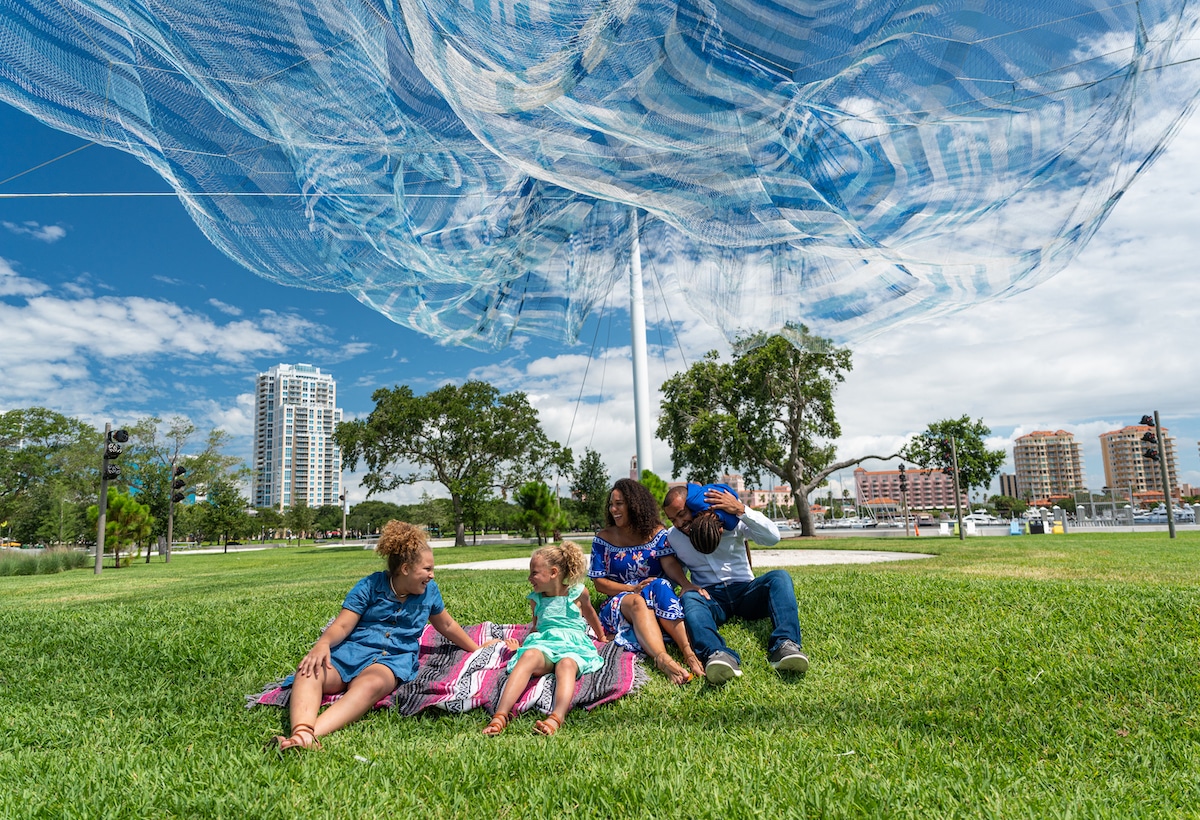
Photo: Brian Adams
Artist Janet Echelman is known for her extraordinary installations, and her latest work in St. Petersburg, Florida is no exception. Bending Arc is a billowing aerial sculpture composed of 1,662,528 knots and 180 miles of twine. Spanning 424 feet and measuring 72 tall at its highest point, the permanent installation is a focal point of the city's new Pier Park.
As the sculpture dances in the wind, it casts shapes and shadows across the park, embracing its visitors. And at night, it's lit by magenta and violet light, which transforms it into something even more magical. Echelman, who was raised nearby on the shores of Tampa Bay, was initially inspired by the blue and white beach parasols she saw on historical postcards. The geometric shapes of barnacles growing on the underside of the pier also shaped her ideas.
But as she dug in further, Echelman found a new significance to her work. She discovered that the location for the project was an important site in the Civil Rights Movement. It was there that citizens peacefully gathered to protest against the city's policy of keeping municipal pools segregated, even after the landmark 1954 case Brown v. Board of Education, in which the Supreme Court ruled that segregation was unconstitutional. In 1955, after being denied access to the public pool, Dr. Fred Alsup and five other black community members sued the city. They won their case, even though the fight continued until 1957 when the Supreme Court declined to hear the city's appeal.

Photo: Brian Adams
Upon learning of this historical significance, Echelman decided to name the work Bending Arc. The phrase comes from a 1968 quote by Dr. Martin Luther King Jr.: “The arc of the moral universe is long, but it bends toward justice.” While the march toward racial equality still continues today, Echelman can take heart in the fact that families of all races will be able to freely enjoy her work.
The massive undertaking of bringing Bending Arc to life was made possible thanks to a collaboration between the private and public sectors. The sculpture was funded entirely by private donors, while the sculpture's infrastructure was part of the new Pier District project. Thanks to the partnership, the public will be able to enjoy the piece for years to come.
Echelman's lightweight sculpture is built to last. The rope is made from fiber used by NASA to tether the Mars Rover, so there's no risk of breakage; it is able to withstand winds of up to 150 miles per hour. (In fact, the rope is 15 times stronger than steel.) And so now it floats gently above the new park, creating a focal point for citizens to gather and remember the history of their city. In doing so, they can look back and learn in order to do better in the future.
Bending Arc is a new permanent installation in St. Petersburg by renowned artist Janet Echelman.

Photo: Visit St. Pete-Clearwater
The 242-foot long floating net is made from 1,662,528 knots and 180 miles of twine.

Photo: Brian Adams
Echelman named the piece after a quote from Dr. Martin Luther King Jr. after discovering that the site was home to peaceful Civil Rights protests in the 1950s.

Photo: Brian Adams
To enhance the drama, at night the installation is lit in magenta and violet.

Photo: Amy Martz

Photo: City of St. Petersburg

Photo: Brian Adams






















































































